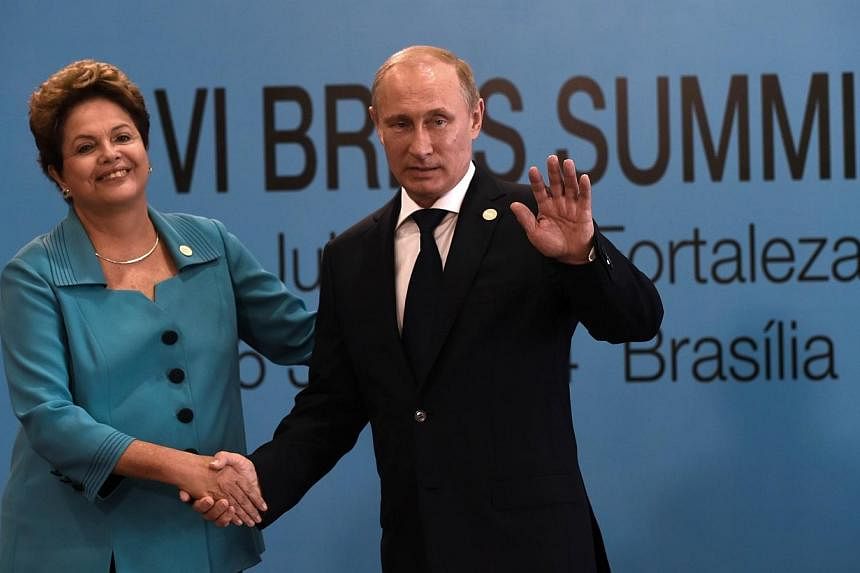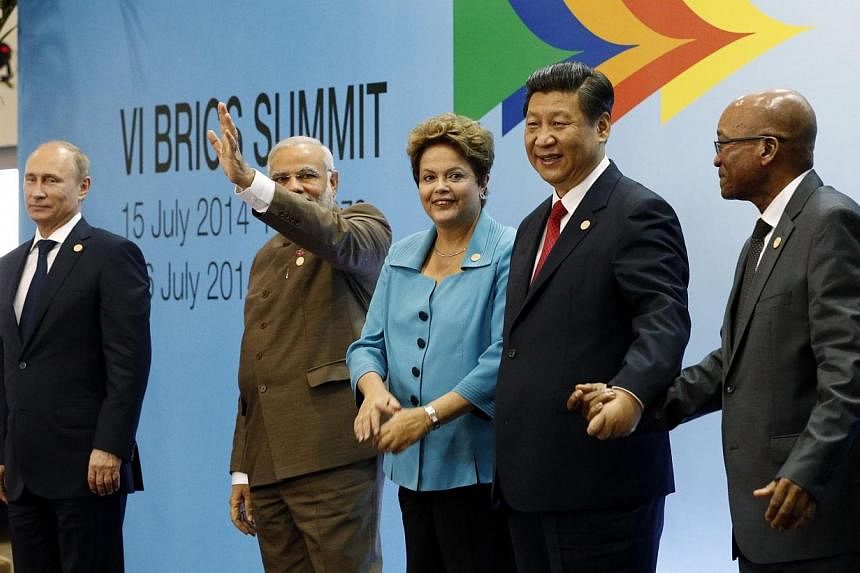At the 6th BRICS summit in Fortaleza, Brazil, on Tuesday, the New Development Bank was created.
The BRICS is an informal grouping of the five major emerging economies in the world, and the name is based on the acronym of the member countries - Brazil, Russia, India, China, South Africa - pursuing a stronger presence in the global financial order.
The New Development Bank is a landmark institution as it will pose a direct challenge to the heavily American-influenced World Bank and International Monetary Fund (IMF) on the world stage.
Developing countries with emerging markets will also have another source of aid and funding, especially with the United States' conservative monetary measures, once the bank is up and running.
1. What is the New Development Bank?
It is a financial institution created by the BRICS nations to finance infrastructure and sustainable development projects in member countries, and in other emerging markets.
The grouping is highly significant, with 40 per cent of the world's population and accounting for 20 per cent of global Gross Domestic Product (GDP).
The idea was first proposed two years ago, during the 4th BRICS summit in New Delhi, India.
Financial weight
The bank will start out with an initial capital of US$50 billion (S$62 billion) that could rise to US$100 billion, funded equally by each nation.
It also includes a currency reserve pool of US$100 billion, called the Contingent Reserve Arrangement, a global financial safety net to be used in case of a currency crisis.
"It will help contain the volatility faced by diverse economies as a result of the tapering of the US policy of monetary expansion," Brazilian President Dilma Rousseff said.
Ms Rousseff added that the group would be willing to "examine" any request from Argentina, which is in danger of defaulting on its debt.
When it will begin operations
However, the bank and currency reserve still require approval from the individual BRICS countries' lawmakers, which could take years.
When it is finalised, the institution will provide the BRICS and other emerging markets more control over funding decisions.
2. First form of institutionalisation
The BRICS grouping had been just an informal arrangement, and more of a discussion group for issues that mattered to developing countries.
"The BRICS isn't a trade bloc, it's a group of letters making up a word and created by an economist," said Mr Jose Augusto de Castro, president of the Brazilian Foreign Trade Association, according to the BBC.
In fact, the five member countries are known for their striking differences in economics and politics.
The New Development Bank is hence the first major achievement of the grouping, and the first formalised agreement since the first summit in 2009.
This economic cooperation undoubtedly has political ripples, as the BRICS abstained from criticising Russia over the Ukraine crisis, instead calling for restraint by all involved and a peaceful resolution to the conflict.
3. Long time coming
Two years in the making, the creation of the New Development Bank was stalled due to negotiations that dragged on.
It lasted so long as the countries sought to block China's attempts to get a bigger share, and as such use the bank as a means to increase its political influence over countries receiving funding in the future.
An issue was the location of the bank, eventually decided as Shanghai, China's financial hub.
Negotiations nearly derailed on Tuesday, as China and India refused to back down while vying to house the bank's headquarters. Only when Brazil compromised and withdrew its request for presidency in favour of India, did they come to an agreement.
Shareholding was another concern. China said that economic strength should be the criteria for contribution. This meant China would have greater control, as the strongest economy in the grouping. India however proposed that each member had an equal share.
4. Sharing of responsibilities
To avoid any accumulation of control in the bank, the BRICS countries will contribute to the initial US$50 billion capital equally.
As for the US$100 billion Contingent Reserve Arrangement, China would contribute US$41 billion, India, Brazil and Russia with US$18 billion, and South Africa with US$5 billion.
Each member country have also been assigned a prominent role each.
China will house the headquarters in Shanghai and India will provide the first president of the bank.
The first chairman of the Board of Governors will be Russian, while the first chairman of the Board of Directors will be Brazilian.
The first regional centre of the bank will be set up in Johannesburg, South Africa.
India will preside over operations for the first five years, followed by Brazil and then Russia. Notably, China will not preside over the bank for two decades.
5. End of Western dominance?
The creation of the New Development Bank and Contingent Reserve Arrangement is a direct challenge to the World Bank and International Monetary Fund (IMF), institutions that have been around since the end of World War II as part of the Bretton Woods System.
"In the IMF and the World Bank, the US and a handful of allies really do make almost all the decisions, and the vast majority of the world… doesn't really have a voice," said Mr Mark Weisbrot, co-director of the Center for Economic and Policy Research in Washington, according to the Wall Street Journal.
The objective of the New Development Bank is to give more representation and voting rights to emerging economies, and loosen the US and Europe's grip over global finances.




